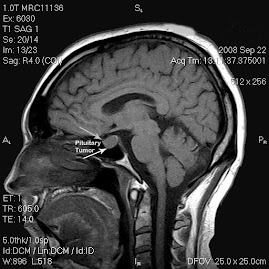I found this information about the surgery. I sure look forward to my actual visit with the neurosurgeon so I can confirm or dispell everything I have been reading. This information says I should plan on taking 2 - 4 weeks off of work. That sounds great, but unfortunately, I can't be gone that long. I need to be making real estate deals.......and, it sounds like I am going to not be able to work out for some time and I may be taking daily doses of stool softners...I'm so excited!!!
What Happens During Surgery?
The pituitary gland is often reached through one of the nostrils. If this cannot be done, an incision may be made in the upper gum, under the top lip. The surgeon then would use x-ray and an endoscope to guide his way to the tumor.
A small piece of bone is removed to expose the pituitary gland and the tumor. Using a microscope to guide his way, the surgeon removes the tumor. If it is too large or stuck to important structures, the entire tumor may not be removed.
Fat from the lower abdomen is sometimes used to close and seal the open area. (I've got plenty there for them to use) This will leave a small incision where the fat was removed.
Samples of the tumor are sent to the pathology lab to decide the tumor type. These tumors are almost always non-cancerous and very slow growing. A final report will be ready in five working days, and you will be told when your doctor will share this with you.
After the Surgery
You will remain in the recovery room one to two hours until fully awake, at which time you will be taken to either NSICU. Most often, your stay will be about 2 days. During this time, nurses and doctors will be checking your arm and leg strength, pupil size, and level of alertness. They will be keeping track of the amount of fluid your drink and you excrete. You can expect to have a catheter draining the bladder the first day, an IV in an arm vein until able to take enough fluid by mouth, and leg wraps to prevent clots forming in the legs.
A cerebral spinal fluid (CSF) leak may occur as a result of this surgery. In this case, a small tube (lumbar drain) is inserted into the lower back to drain the fluid into a bag. This drain will decrease the spinal fluid pressure and allow the area to heal.
Pain
You may feel more pressure in the head or have a headache. Pain medicine will be ordered and ready if this occurs.
Nasal Spray
There may be nose stuffiness for a few weeks. It may be helpful to do gentle nasal washing with sterile saline to clear out blood and mucus. Sterile saline may be purchased at your local drugstore.
Activity
You will be asked to get out of bed the same day or the day after, and to slowly increase your activity in order to be walking in the halls before discharge. Walking is the best exercise.
You should avoid bending from the waist or straining to lift for 3-4 weeks. Bending and straining could cause a CSF leak.
For 3-4 weeks, you should avoid coughing, blowing the nose, sneezing, drinking with a straw, and straining while having a bowel movement. These things increase pressure in the head and may lead to an opening at the site (causing a CSF leak). If there is a need to sneeze, you should keep your mouth open to avoid pressure. To prevent the need to strain at stool, you should eat foods with fiber, drink at least 8 8-ounce glasses of fluid each day, and use stool softeners as needed.
Diet
You will be offered clear liquids first, returning slowly to a normal diet as you are able to take solid food. If there is an oral incision, soft foods may be best. Rinsing the mouth gently after eating will keep the incision clean. You should not brush over this area with a toothbrush.
Going Home
Depending on how you are feeling and the level of fatigue, plan to take 2-4 weeks off work and have someone help with housework for a few days. The amount of time needed for recovery depends on the person.
Follow-up
A clinic visit with the surgeon about one week after discharge will be scheduled before you leave the hospital. This doctor will decide how often you need an MRI.
On the day of the clinic visit, a blood test will be done before seeing the doctor. Because this surgery may disturb your hormone levels, you may need to take hormones for some time. You may also need to be followed by an eye doctor and an endocrine doctor as well as the surgeon.
When to Call the Doctor
Increased amount of nasal drainage
Fever greater than 100.5°F
Foul taste in the mouth
Signs of a CSF leak (often made worse with movement)
Constant drainage down the back of the throat
Cear fluid draining from the nose
Headache
Nausea or vomiting
Signs of sinus infection (in a few weeks or months)
Green nasal drainage
Headache
Fatigue
Increased nasal stuffiness
Signs of a low blood sodium level
Nausea
General weakness
Headache
Subscribe to:
Post Comments (Atom)


No comments:
Post a Comment